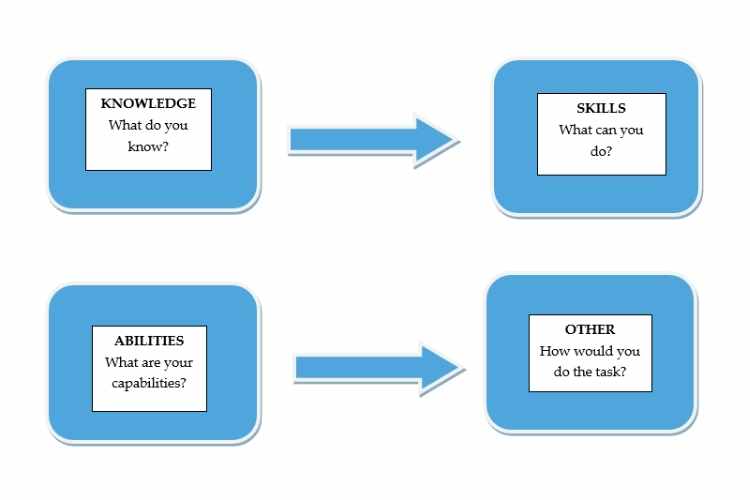In this blog we are going to tell you about KSAOS, so read this blog carefully to get the complete information.
Knowledge, Skills, Abilities, and Other Characteristics, or KSAOs, is a typical abbreviation for human capital. KSAOs are characteristics of a candidate or employee that are taken into account during the hiring process, performance evaluation, and career development. Every position and organization demands that its employees possess KSAOs pertinent to the duties of the position and the organization. Large firms conduct a job analysis to determine the pertinent KSAOs each employee needs to successfully complete a task. Employing HR consultants and other pertinent subject matter experts is typically part of this procedure. An in-depth discussion of KSAOs and KSAO examples is provided in this article.
K for Knowledge
Knowledge is the body of applicable factual or procedural information, such as proficiency in a second language or computer programming languages. The majority of information and competence are learned through formal education and technical training. An individual needs some kind of higher education, such as a Bachelor’s degree or a Diploma, to have knowledge in a certain subject, like the field of engineering or auditing. The amount of education and technical training a person has, with a Ph.D. being the highest level of education and training, determines how much knowledge they have in a given profession.
A person who has earned a Ph.D. will be knowledgeable in a certain field. Depending on the needs and requirements of the role, a different level of expertise is needed for each job title and position. A doctorate would be the most suitable degree for some positions that call for the highest level of training, such as the role of a lecturer in a higher education institution. On the other hand, a person working as a graduate trainee will require a bachelor’s degree at the very least. Employers will be skeptical of you if you apply for graduate trainee employment with a Ph.D. since you are overqualified for the post. Training programs for employees aid in enhancing subject expertise.
S for Skills
The abilities needed to complete tasks correctly are known as skills, and they include psychomotor abilities like typing speed or driving ability. The expertise or talent required to complete a task or job is another way to define skills. Hard skills and soft skills are the two categories into which skills are divided. Hard talents are those that can be learned or acquired over time. They might be categorized as technical talents as well. Hard talents include things like driving ability. If a company needs a driver, the ideal applicant should hold a current driver’s license with the appropriate class for the vehicle they will be operating. Driving is a skill that must be learned; it is not a skill that comes easily.
On the other side, soft talents include leadership, research, problem-solving, critical thinking, and so forth. These abilities, also known as core skills, can be learned and developed as well as be innate traits of a person. Through a foundational education and technical training, core skills can be built. It cultivates skills for lifelong learning, which are essential in this chaotic atmosphere. Strong core abilities enable employees to quickly adapt to organizational and technological changes.
A for Abilities
Empathy is one of many cognitive, sensory, and physical talents that are more stable traits. Since abilities are largely innate traits of an individual, they are less dependent on instruction and development. According to the Oxford Dictionary, an ability is a remarkable aptitude or skill. Employers evaluate a candidate’s suitability for a position by examining how well they can carry out the many tasks necessary for the organization’s operations. The hotel would need to hunt for someone with the ability to sing if it wanted to hire a performer to sing in the hotel lobby.
A person with a frog-like voice cannot be trained to have an angelic voice, no matter how hard you try. Although skills can be developed by constant practice and coaching, they cannot be taught, which is why they are occasionally referred to as special skills.
O for Other Attributes
Your attributes are a combination of your personality, traits, attitudes, interests, temperament, and values. These are sometimes referred to as “Other Attributes” in HR. While characteristics are frequently essential to a job’s success, job seekers frequently underestimate their importance. Employers claim that they seek out candidates who have the proper attitude, who will mesh well with the rest of the team, and whose values align with those of the business.
Your resume’s content can incorporate qualities, such as the terms “confident,” “dependable,” “curious,” and “determined.” It’s important to discuss your qualifications with a potential employer, but some terms have lost some of their meaning due to overuse. Therefore, the rest of the content on your resume must support and back up any attributes you choose to add.
Conclusion
The components that are used to evaluate a person are KSAOs. The assessment can be used for performance reviews and career development in addition to recruitment. Employers can see where a candidate falls short and where they can help them so they can complete their job as effectively as possible thanks to KSAOs. The organization has to identify skill gaps in order to plan its upskilling and reskilling strategies. Let’s say a manager discovers that an employee just has a basic grasp of their position. Instead of firing the worker in this situation, the employer could suggest that they pursue certifications to fill in any skill deficiencies. Therefore, it is evident that KSAOs are crucial to the development of human capital.
We Hope this blog is sufficient enough to provide the information about KSAOS. Thanks for reading this blog.
